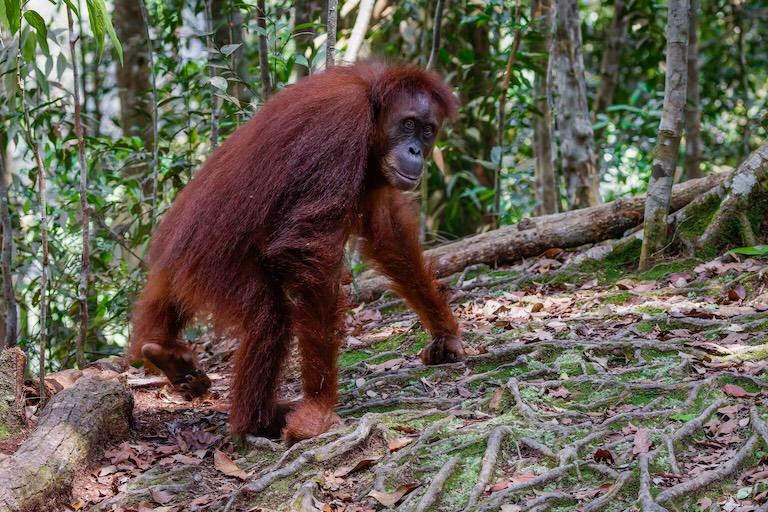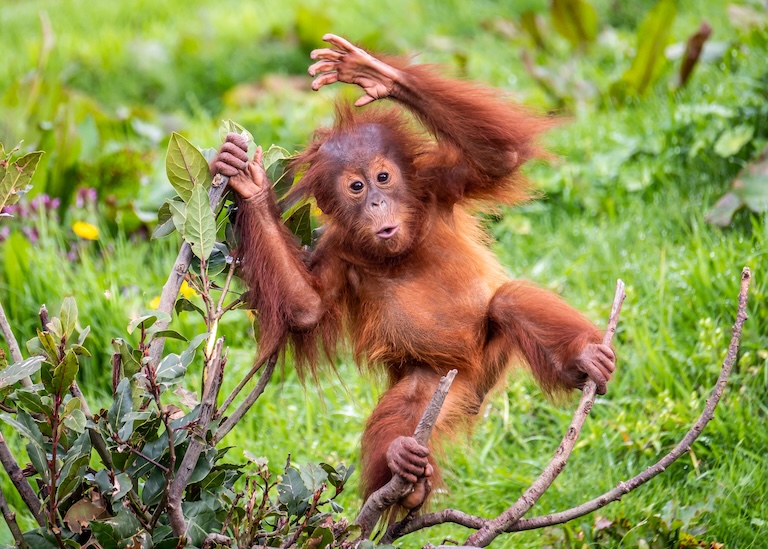Sumatran Orangutan Profile
Unlike most of us, the “forest people” of Indonesia are quite content with being called apes. They spend time up in trees, eating fruit, and being generally quite chilled out. The word orangutan is Malay for “people of the forest”, and this descriptor has therefore been accepted for some time by the local human populations, but is recently making its way into Western definitions, too.
And the Sumatran orangutan, a true person of the forest canopy, is perhaps the most deserving of the title.

Sumatran Orangutan Facts Overview
| Habitat: | Moist lowland forest, montane forest and peat swamps |
| Location: | Northern Sumatra, Indonesia |
| Lifespan: | Up to 58 |
| Size: | 1.7m (5ft 6in) |
| Weight: | Up to 90 kg |
| Colour: | Orang |
| Diet: | Mostly fruit, but sometimes young and mature leaves, seeds, shoots, pith, flowers, insects, and rarely meat |
| Predators: | Tigers, leopards, pythons |
| Top Speed: | Around 8km/h (5mph) |
| No. of Species: | 1 |
| Conservation Status: | Critically Endangered |
Orangutans are ancient people of the forest, and since our species left the forest, we’ve unfortunately set about doing what Trump’s currently doing to the White House. But the forest is not a mere piece of American sentimentality – it is our ancestral home, and more importantly now, the home of people like the Sumatran orangutans. These slow-living, slow-breeding, charismatic apes are gentle, curious, and almost extinct.
Interesting Sumatran Orangutan Facts
1. They’re ancient
The hominid history of Southeast Asia is fascinating and mysterious to this day. This is the location of the oldest hominid fossils outside of Africa, and 200,000 years ago or more, Denisovans were the native human species. Or, at least, one of them. Even these might turn out to be made up of three or more species if more data comes out, but they certainly weren’t alone. Neanderthals were likely there, as well, and a species of tiny human called Homo floresiensis lived on Flores Island in Indonesia up until 50,000 years ago, when our species arrived and did what we do to everything.
But our ape family isn’t comprised only of humans. Gigantopithecus is a mysterious, extinct ape from the region that may have stood 3 metres tall and weighed as much as 300 kg. Then, there were extinct orangutan species, too, like Pongo weidenreichi, about a fifth larger than the modern species.
Today, there are only four recognised species of hominid left in Indonesia: Our species and the Bornean, Tapanuli, and Sumatran orangutans.

2. They’re loose
Orangutans are some of the least social of the Primate order. Many groups are almost entirely solitary, which is unusual for a primate and otherwise unheard of in the great apes (outside of animal bloggers, of course).
But of this group, the Sumatran orangutans are the most social. They gather together to eat figs, and come and go as they please, not really showing any affiliation with or opposition to any particular network.
This makes them very loose, socially, which tracks with their casual, tree-swinging style, too. In fact, they’re the most accomplished apes up there.
3. They are the largest arboreal animal in the world
Sumatran orangutans are the second-largest species of orangutan, and a big male will weigh up to 90 kg. Bornean orangutans are marginally heavier, but it’s a close call. As a whole, orangutans are the largest arboreal animals on the planet, and while Sumatran orangutans might not be the heaviest, they are the most arboreal of the three species.
Female Sumatran orangutans may live their entire lives without touching the ground, and this is a product of two key features: the first is a high degree of specialty – Sumatran orangutans can’t handle patchy forest as well as their Bornean counterparts, as a result of this. Even with very selective logging, this species can suffer catastrophic declines in population in relation to habitat destruction.
The second is one of humanity’s greatest historical threats since leaving Africa: the tiger.
Sumatra still has (very few) tigers, and they’re enough to keep these huge apes up in the canopy. This relationship between big cats and arboreal primates is essentially a lens we can use to peer back into our own ancestry.
4. They exhibit multiple mating strategies
Mature males of all species will often develop the recognisable “flanged” faces – these undeniably wide cheeks. This is not a guarantee, though, and so there are two morphs of the mature male in orangutans: one with the flanges, one without.
This is weird, to say the least, at least in mammals, so like us. And both the flanged and unflanged males have different social and mating strategies.
Flanged males are inherently larger and therefore more dominant. They avoid conflict by staying well out of each other’s way, but unflanged males aggregate during mating season and tolerate one another rather well.
The flanged male’s job is to court the females, and the unflanged males are there to sneak in when he’s not looking and mate behind his back, often against the will of the female victim. 1 2
5. They can kill
Orangutans are some of the most chill-out animals you’ll ever find, but even they have their limits. Diets are primarily made up of fruit, but insects and leaves fill in most of the gaps in nutrition, and on occasion, they’ll hunt the adorable slow loris.
This fresh meat gives a handy boost of protein, for what is essentially a very slow-growing animal. 3

6. They breed slowly
Orangutans exhibit 6–9-year birthing intervals, the longest of any primate. But this strategy works well if it is not interrupted.
Infant mortality in orangutans can be as low as 5% to 6% in the first year, far lower than our own, before modern medicine got involved.
Females take 15 years to reach birthing ages, and infants are only weaned after 7 more.
This is a high-risk, high-reward strategy, and one that we see in our own species. Unfortunately, the only thing bringing that high risk to the orangutans nowadays is us. And for how much we go on about being the smartest animal, we should really know better by now.
7. They’re people
At first glance, the non-human personhood concept may appear to be another one of those virtue-signalling exclamations commonly yelled into faces by uneducated idealists standing under a placard.
But this isn’t some meaningless chant meant to reiterate tribal status; this is a real thing. And something that science is rapidly supporting as cognition and behaviourism grow, and concepts of divinity give way to more realistic visions of ecological communities, shared experiences, and non-human consciousnesses and cultures.
Orangutans are just one of countless species deserving of the title of personhood, a word that signifies an inherent right to dignity, respect and general consideration on the very same grounds we consider ourselves to be.
It’s a product of our bias that this process of recognition has begun with our closest relatives, but baby steps are still steps, and in 2008, Spain became the first country to recognise non-human great apes as “People”, and to claim that this should logically exclude them from things people shouldn’t suffer, such as animal testing, lives as exhibits in zoos, and the unrelenting destruction of their homes.
Orangutans are some of the smartest, kindest, gentlest people you could ever meet, and when we begin to consider our community members in this context, we rightfully find it a lot harder to tolerate their destruction. 4
Sumatran Orangutan Fact-File Summary
Scientific Classification
| Kingdom: | Animalia |
| Phylum: | Chordata |
| Class: | Mammalia |
| Order: | Primates |
| Family: | Hominidae |
| Genus: | Pongo |
| Species Name: | abelii |
Fact Sources & References
- , “Relationships & Mating Strategies ”, Orangutan Republik Foundation.
- (2017), “Sumatran Orangutan”, IUCN Red List.
- (2024), “Orangutans (Pongo spp.) Fact Sheet: Diet & Feeding”, San Diego Zoo Wildlife Alliance Library.
- Lee Glendinning (2008), “Spanish parliament approves ‘human rights’ for apes”, The Guardian.
